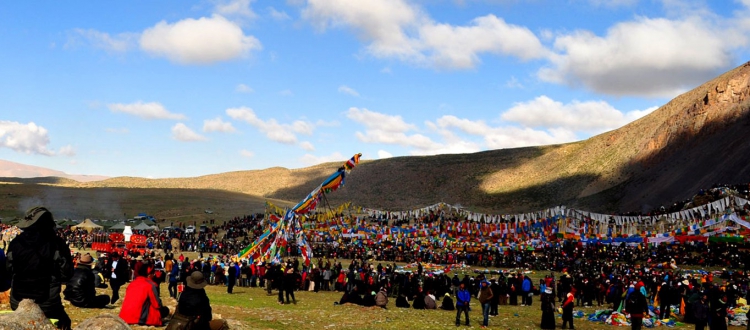Buddhist Times - IN
About Tibetan people

The Tibetan people are an ethnic group native to Tibet. Their current population is estimated to be around 6 million. In addition to living in Tibet, significant numbers of Tibetans live in other parts of China, as well as India, Nepal, and Bhutan.
The Largest Tibetan Tiger Carpet ever made in Nepal
Mandalas Life is pleased to introduce the Largest Tibetan Tiger Carpet to all Tibetan Tiger lovers. The size of the carpet is 335 cm wide and 457 cm long (11*15)ft.
This Tibetan Tiger Carpet is a rare and top-quality rug that conveys the warmth of handmade products.
Historical context and meaning of the Tiger Rug in Tibet
Tibetan Tiger Carpets are made traditionally, each design is cut by hand to create a 3-dimensional look that emulates a .
Representation of Dragons in Tibetan Culture
Tibet has the largest tradition of Dragon which dates back more than 7000 years. Dragons are not just mythical stories or just some curiosities. They are part of Tibetan life and culture. The symbols of dragons are everywhere from the beginning of Tibetan history and the importance is still up until today.
In Tibet, Dragon is considered as one of the dignities. There is a total of four dignities. Tiger, snow lion, and the Garuda .
36 measurements of Tibetan Buddhism figures
This 18th-century essay drawing is similar in content to the photographic measurements. The so-called "image measurement" is the scale of the Buddha's human body and the scale of the figure.
This may be a reference guide for the painting of Buddha statues in Tibet or Nepal in the 18th century. It contains 36 detailed drawings and the text is in Tibetan.
The representation of the Buddhist figure is not fabricated out of thin air. The proportions, .
Traditional Tibetan Carpet Making Process
Tibetan carpet making is a traditional craft. Tibetan people love art and craft. Tibetan carpets are traditionally made from Tibetan highland sheep's wool, called changpel.
Tibetans use the carpet for many purposes ranging from flooring to wall hanging to horse saddles, though the most common use is as a seating carpet.
Tibetan Carpet with Tiger Design
The knotting method used in Tibetan carpet making is different from that used in other carpet-making traditions worldwide.
All the carpets .
Characteristics of Tibetan Art – a psychological and meditational practice
Tibetan arts started from the rock paintings in ancient time and its subjects ranged from animal images of deer, ox, sheep, horse, etc to hunting scenes. Tibetan arts have flourished very well during the period of the Tubo Kingdom. Especially after the installation of Buddhism in Tibet, religious paintings made a more progress.
Introduction to Tibetan Art
The heritage of conventional Tibetan crafts and the fusion of India, Nepal and Han People’s art essence make Tibetan .
The Dalai Lama Lineage through the Himalayan Arts
Dalai Lama is the most recent in the huge line of lraders of Gelug branch of Tibetan Buddhism. He is considered to be an exemplification of Avalokiteshvara or Chenrezig, the Bodhisattva of Compassion, and thus the defender of Tibet. Bodhisattvas are realized beings inspired by a wish to realize Buddhahood for the advantage of all sentient beings, who have vowed to be reborn within the planet to help humanity.
In 1578 the Mongol ruler Altan .
Depicting Tsangyang Gyatso Thangka
Dalai Lama and Tsangyang Gyatso were born in 1683. The Sixth Dalai Lama and Tsangyang Gyatso were perhaps the most popular Dalai Lama. The discovery of Tsangyang Gyatso was kept a secret by the regent Desi Sangye Gyatso until the construction of the Potala Palace was complete.
Tsangyang Gyatso was in no way a model of his predecessor The Great Fifth. Tsangyang Gyatso enjoyed the life of a layman and is best known for his .
The Journey of Buddhism from Mongolia to the Himalayas
Buddhism in Tibet started in the sixth century. It was transmitted by the great Buddhist teacher of India for the next eight years. Tibetan Buddhism begins with Bon. The Bon religion of Tibet was animistic and shamanistic, and elements of it live on today, to one degree or another, in Tibetan Buddhism.
Introduction of Buddhism In Tibet
When Buddhism was introduced into Tibet in the seventh century under King Songtsen Gampo, it was apparently centered in the .
Avalokitesvara Mahayana Pantheon
Who is Avalokitesvara?
Avalokitesvara, the bodhisattva of compassion, is one of the most important and popular Buddhist deities.
Avalokitesvara first appears in Indian Buddhism. He is originally mentioned as one of a number of bodhisattvas.
Avalokitesvara is famous in the Mahayana Pantheon as a Bodhisattva emanating from the Dhyani Buddha, Amitabha, and his Akti, Pandara.
Who is Pandara?
Pandara, Buddhist goddess, is the Shakti of Amitabha, and a feminine bodhisattva. She originated from the Tantric syllable PAM. Her color .
The Yogurt Festival / Sho Dun Festival
The Sho Dun Festival is commonly known as the Yogurt festival and is an annual festival that is celebrated at Norbulingka or "Jewel Park" palace in Lhasa, Tibet. It is named yoghurt festival because yoghurt is offered to the monks who happen to finish their meditation retreats.
It is a week-long gala celebrated in the summer, from the 15th to the 24th of the 5th lunar month. It usually falls on the mid of August. This year it is from August 11th to .





















